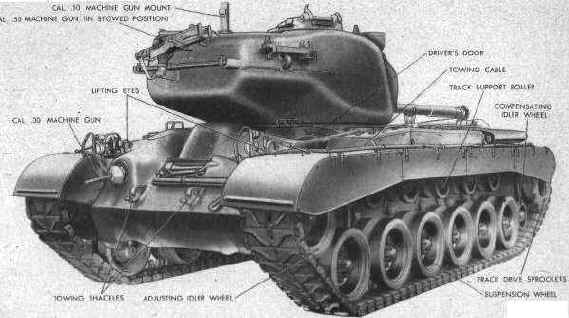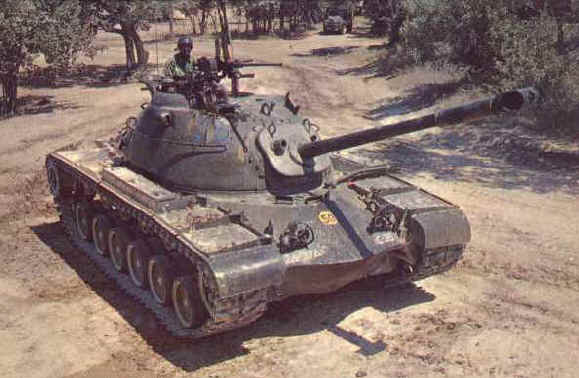| DEVELOPMENT OF THE M-47
A US Panel on Armour was appointed in
1949. This group devised an integrated program of tactics, organization
and a proposed family of tanks to replace the corresponding tanks
available at the end of World War II. The rebuilt M-26 Heavy Tank had
become the M-46 or Patton Tank by the substitution of a new engine and
transmission but was considered only an interim vehicle. The new designs
were known respectively as the T-41 Light, the T-42 Medium, and the T-43
Heavy Tanks, all to be equipped with the new engines and transmissions.
An
M-26 Heavy Tank had been fitted with a new 90 mm. gun, becoming the M-26
El. Another was fitted with a new engine and transmission and became the
M-26 E2 very briefly and then, with some additional modifications,
became the T-40 Medium Tank. This vehicle became the basis for the
rebuilding program on the M-26 Heavy Tanks. These, after rebuild, to
become the M-46 Medium or General Patton Tanks.

In 1950, a Reorganization Act changed
the Armoured Cavalry to Armour but, as with the Armoured Cavalry,
without a Chief of Branch. As a matter of fact, none has existed to this
day. The Korean War had begun in June 1950 but the T-42 Medium Tank
design, which was to have become the standard post-war medium tank, was
not quite completed at the time the war began. One of the T-42 turrets
was mounted on an M-46 tank to become first, the M-46 El, and then,
because it was a marked improvement, became the limited standard M-46
Al. When the T-42 was completed, it had a five bogie wheel chassis with
three support rollers. The tracks were detachable pad chevron type.
Final drive was in the rear. There was an exhaust muffler over the
tracks on each side. The travel lock for holding down the 90 mm. gun was
offset to the left rear of the hull, which resulted in the gun being
carried at a slight diagonal instead of the conventional method of
pointing directly to the rear.
The 90 mm. gun forming the main
armament was fitted with a bore evacuator but no muzzle brake. The
turret was slightly elliptical with a long bustle or rear turret bulge
which acted as a counterweight to the gun. At the end of the bustle
there was a stowage box. No stowage rails appeared on the turret sides
but there were loops for tying down a camouflage net. The turret
included a range finder, the "ears" of which protruded in the
form of stubby cylinders. Pistol ports were in the turret sides.

Various modifications were made for
experimental reasons. One of these was the installation of "fender
kits". Fender kits were self-contained armoured boxes mounting a
M-1919 A4-30 calibre Browning tank machine gun, 680 rounds of
ammunition, a pneumatic charger, a firing solenoid and an air supply.
These fender machine guns were fired by the tank driver. They were
mounted, one at the front of each fender or mudguard.
The needs of the Korean War were such
that existing vehicles had to be used, so the T-42 was never produced as
a standardized vehicle. The turret, however, was such an advance that it
was decided to produce a composite tank with this turret and to
standardize it without going through the process of testing.
ARMAMENT
The main armament was a 90 mm. gun
mounted in the revolving turret. Again, not all the weapons were exactly
alike. Some had the M-36 gun and the flaring muzzle brake as used on the
M-46 tank. Some had a different gun with the T-head blast deflector and
some had the cylinder type blast deflector. All had bore evacuators.
Originally, there was, co-axial with the main armament, a 50-caliber
Browning machine gun but later, the standard 30-caliber Browning machine
gun was substituted. Both were fed through ammunition chutes and an
electric booster motor. There was a 50-caliber Browning machine gun on a
rotating ring on the commander's hatch but this was later replaced by a
50-caliber machine gun on a fixed pintle mount. Both were free aiming
weapons. A 30-caliber Browning machine gun, with a depression of-10
degrees and an elevation of +24 degrees, was located in the right
glacis. It was tracer aimed by the co-driver through his hatch cover
periscope.
by Colonel Robert Icks |